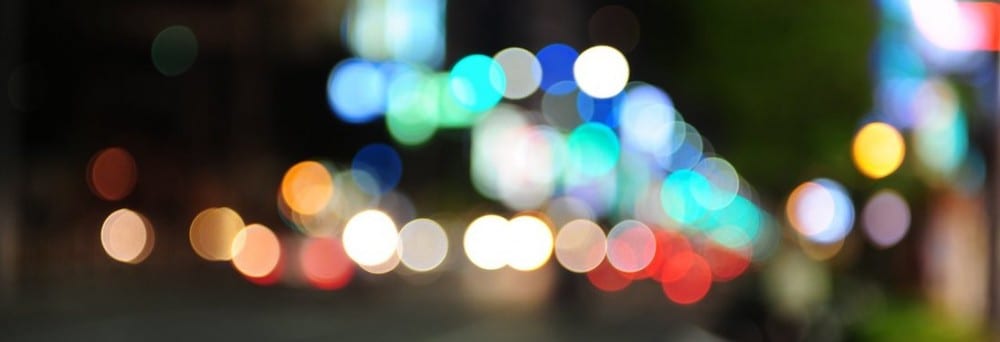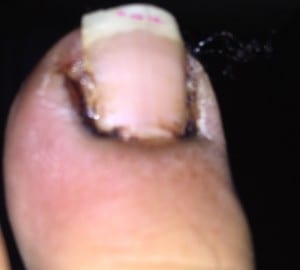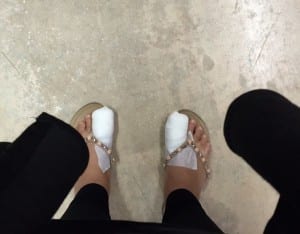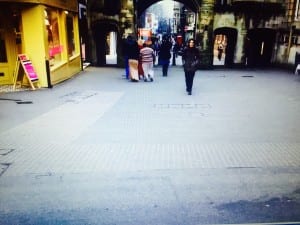Framing Statement
In Anna Birch and Joanne Tomkins introduction they tell us as the readers, that site specific performance is a type of art which “is difficult to define, attempts to pin down a mutually agreed-upon understanding of ‘place’ – in either precise physical or metaphorical terms.” (Birch and Tompkins, 2012, 4). My understanding of a site performance is that it is has to be specific to the place. If the performance can be performed in an alternative location; then it doesn’t meet the requirements for the site. Nevertheless if it does not meet the requirements for the site, than it does not make it a successful performance. Mike Pearson states “At site, many things may be happening: performance may need to establish and proclaim its own presence” (Pearson, 2010, 17). I can agree; as in my performance, I accomplished what I wanted to achieve as I embraced the surroundings which was now included in A Journey to Now. What may happen at the site is unpredictable nonetheless you have to be prepared as it is all included in the performance.
After much speculation, my final site specific piece was centred on my life, walking and my two big toes. A walk structures what we see, walks are fluid and they move us through places, not only physically but mentally too, they allow us to think and remember and go into our own world. Walking triggers feelings. Walking is precious, our feet allow us to do this. Take care of them.
Problematic feet have been a part of my life for the past 6 years. If it wasn’t pain in the souls of my feet, it would be pain in my two big toes. Nevertheless in the last year I discovered that I had the painful condition of ingrown toenails. Unfortunately this caused me to have no choice but to have partial nail surgery. This has triggered a significant amount of change and disruption, to my normal day to day life. Throughout our site specific performance studies, I soon recognised “the individual is challenged to navigate their own journey through the performance event reliant upon a deeply personal form of conceptual and phenomenological engagement” (Hunter, 2015, 474). To have a successful performance you need to connect with the site. I learnt that if you care about your topic and you have a personal connection, you are more than likely going to have a memorable and unique performance. “Memories of this performance will stay with me and be evoked when I walk around” (Hunter, 2015, 473). My piece was real, it had no acting; it was A Journey to Now.
(January 15th 2015, My Left Toe)
Liberation was the stimuli we had been given to create our performance. What did liberation mean? Liberation can be taken down many different pathways. Nonetheless I perceived it as freedom; liberating yourself from an oppressive matter. I have always been extremely embarrassed of my feet condition; I don’t like talking about it and I don’t like people to know about it. This was my truth and I wanted to free myself from these issues. Even though telling stories of my feet will not resolve the problems, sharing them does help.
A Journey to Now was heavily influenced by practitioners such as Carl Lavery autobiographical text – Mourning Walk, Michel de Certeau – Walking in the City and finally Conan Lawrence – Amelie Daems’s Feet.
My site specific location was Lincoln High Street, this fit my performance perfectly. Ever since I joined Lincoln University, I have had ongoing issues with being able to complete simple journeys on foot. I would have to wear flip flops not only summer but winter months too. I could barely walk after my partial nail surgery. The first walk I successfully completed without having to stop, was a 27 minute walk from the top of castle square down to the LPAC. To an audience, this might seem strange but to me that was a journey, I never imagined being able to complete. The site specific performance had to have a connection with the Frequency festival who use techniques such as pervasive media. Taking this in to consideration, I decided on a video piece which was projected in the studio, while I was story telling alongside. Recording a video allowed me to liberate a moment in time, it allowed me to rescue the moment. My performance A Journey to Now took place on the 9th May.
(January 6th 2015, My toes after partial nail surgery)
Analysis of Process
Pervasive media is one of the first topics we looked at during the beginning of our site specific module. “Pervasive Media is Digital Media delivered into the fabric of real life and based on the situational context at the moment of delivery” (Pmstudio.co.uk, 2015). This media concepts allows performance to use different types of technology such as, mobiles, internet, and projectors; to bring images, videos and games to your piece. Media such as this fits perfectly with the liberation theme as there is so much you can do with it and it links perfectly to the frequency brief. The frequency festivals work portrays pervasive media throughout. Pervasive media uses “technology to understand something about the situation and respond based on that information” (Pmstudio.co.uk, 2015). Such as A Journey to Now a pervasive media technique allowed me to capture video graphed moments which I never intended on having in my performance; such as the building works in Lincoln which symbolised the high street needed to be fixed such as my feet. The Poundshop which triggered memories from holidays with my family in Cyprus, the early morning walks I was forced to go on with my uncle between the ages of 7-14. The video helped me capture and remember moments, which allowed me to have greater context in my final performance. Indulging these new and radical forms of pervasive media, mapped changes and helped me enhance an interactive narrative, throughout my site specific performance. Pervasive media as a stimuli allowed me to explore and “understand new forms of collaborative art. (Hales and Kelomees, 2014, 4).
My first solo task was one of Carl Lavery’s 25 instructions. I had chosen instruction 22 “Sit in a park, café or bar and listen to the stories spoken around you” (Lavery, 2005, 236). I chose Costa on triton road, a fairly busy coffee shop. The reason for this; I thought it was interesting to see how humans behaved and to observe and people watch. I believe I could have create a performance about the world and the different lifestyles people live. The different emotions, feelings and atmosphere we as humans can create.
It took me a while to decide on a definite topic for my performance. Nevertheless watching Unfinished Sympathy by Massive Attack and Bitter Sweet Symphony by The Verve gave me the set idea of going ahead with a video performance.
(The Verve, Bitter Sweet Symphony, 2009)
(Massive Attack, Unfinished Symphony, 2009)
Instantly after watching both the videos, it was clear that they were equally going for a similar approach. This was to have the camera shadow the artist walking around the city. I believe these ideas were very clever and thought out, so simple yet so rewarding. Observing the videos you get so much out of them, watching the world go by. Seeing what people get up to in their daily life. Nonetheless this gave me the idea of producing a video performance for my Site project. I thought of the idea to walk down from the top of the high street location to the LPAC. However what I would do different is to not have myself walking in the video, I would rather catch the moments of the public’s daily life. People tell a story with the way they walk and the way they are dressed and the routes they choose to take. I feel as though there is always so much happening on Lincoln High-street as it is so busy, this would be aseptically pleasing for the camera. This would be liberating a moment in time as I will be rescuing moments not just of the public but of the buildings too. It is extremely easy to overlook or lose track of everyday life. The simplest day to day tasks are forgotten. On the other hand, I will also be able to relate this to myself, as I have issues with walking. Ingrown toenails have created a great distress towards my life during university. Creating this journey and recording it will allow me to never forget the moment I was able to free myself from the clutches of my feet and walk from castle square, down Lincoln high street to university.
While reading Michel de Certeau, Walking in the City, I found it absolutely fascinating. De Certeau Walking in the City really relates to the type of work which I was looking at doing. I used this text as inspiration. “Michel de Certeau analyses an aspect of daily urban life. He presents a theory of the city, or rather an ideal for the city, against theories and ideals of urban planners and managers, and to do so, he does not look down at the city as if from a high-rise building – he walks in it” (Certeau, 1988). The best way for me to capture the moments for my performance, is by actually walking the route instead of sitting and observing. Journeys create maps and makes you realise the space that is organised by streets and buildings. To give my performance clarification, I needed to get to know my site better by continuously revisiting the journey that I wanted to create.
Walking at the top of castle square brings back memories of walking on the uneven pebbly pavements in Cyprus. The cobbled streets on steep hill triggers thoughts of the walks I was forced to do with my uncle at 5am. If I could go back, even though walking was not my favourite hobby, I would go on those walks with my Uncle without complaining.
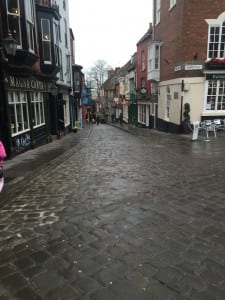
This is where I begin my journey of the walk and reading Amelie Daems’s Feet by Conan Lawrence, makes me wonder how it would feel to do the 20 minute journey bare foot (Lawrence, 2012). Never mind Amelie Daems’s who walked all the way across Belgium taking her four weeks. “Four weeks of walking leave a foil on the sole, tracks to catch up on the journey just made. Grids, contorted boxes, cross-hatchings; knots of repeated pressure, sweat and balancing (walking as a continued attempt to refrain from falling). Toes bunched up, repeatedly curled into or against contours and sleights of land. A heelprint’s finely striated, bonded reply to ground. The body’s isobaric chart tucked out of sight.” (Lawrence, 2012). The walk that Daems’s has accomplished will never leave as the markings on her feet from the performance will never leave her. Yes physically the marks on her feet may leave but some may scar and even if they do vanish she will always be able to remember the effect that walk had on her feet. This could be seen as creating a map on her feet. The markings are creating another journey solely for her feet.
Many people can walk for hours without their feet hurting, getting blisters or cuts however others can’t. Looking at the concrete at the start of my journey, I couldn’t imagine anything worse than walking down it without shoes. The cobbles pressing into feet, especially my feet which are so sensitive will leave a harsh mark. There has been times when I have been out, and have had to take off my shoes from the pain. Unfortunately I would have to walk back home on the concrete and I could feel every grain on the floor. Nevertheless, what I did was wear some uncomfortable sandals not my usual, to walk down the cobble street and by the time I got to the bottom, my feet were throbbing. Not having the comfort of my usual shoes, gave me great pain in my feet. Walking is something which we have to do every day, whether it’s a small journey or a big journey. It’s an important aspect to our daily life’s, we get comfortable and we know what’s best for our feet. The walk Daems’s did in my opinion was a fascinating because I’m sure many people would not be able to complete that journey.
The Idea of Daems’s creating a map on her feet presented myself and my tutor with the idea of map making. Creating a map on the soul of my foot using a representation from the walk I made. I printed out the journey I accomplished on google maps, and asked an audience member to draw the line on my foot, symbolising the scaring from Lincoln High Street.
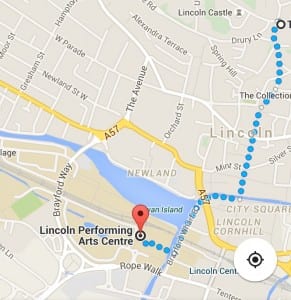
(March 6th 2015, Google Maps – Castle Square via LPAC)
Conan Lawrence piece on Amelie Daems was my biggest influence as I could really relate to her. Even though a 4 week journey across of Belgium is totally different from a 27 minute walk down Lincoln High Street; I can imagine the excruciating pain she was in. Feet are so precious and you need to look after them. I can only sympathise with the agony she must have been in, and I comment her for being so brave. The way Lawrence has used descriptive text to describe Daems experience, has given me the idea to write a performance text for my own story telling alongside my video. This text consisted of when my problems with my feet began, memories of walking and links involving my chosen site. To help me do this, I would frequently take the walk that my site requires. This aided me to get a better feel and understanding of my site. It was stimulating to just walk in silence and observe what was happening around me. Listening to people’s conversation, looking at their facial expressions, just watching the passers go by. The speed of peoples walking, the urgency or the tranquil walks. Observing the buildings and the architecture. The old city known as Lincoln.
(March 8th 2015, Lincoln High Street)
The chapter Mourning Walk by Carl Lavery in the book Walking Writing and Performance, is a special chapter, a very personal chapter about Lavery taking an 18 miles journey to mark the ninth anniversary of his father’s death. At the end of his Journey he performs a ritual in a field. We never find out what that ritual is, whether it was something minimal or something complex. Lavery believed that not everything had to be shared “Certain things are ought to be kept a secret” (Heddon, Lavery and Smith, 2009, 28) . The walk allows Lavery to reminisce and help move him through a hard time. I felt trapped when I couldn’t take the smallest of walks and now that I have accomplished my half an hour journey down Lincoln high street to the studio it has moved me in more ways than one. I will never forget this specific, site specific walk. “Walking is a technique of solitude, a way into reverie. The walker is not a sleepwalker but a daydreamer […] when I walk, I go back and forth in an infinite journey between memory and imagination” (Heddon, Lavery and Smith, 2009, 32).
Lavery’s Mourning Walk inspired me to perform my own rituals alongside my performance. I not only wanted to tell my story but I wanted people to see. My rituals were going to be exactly what I do on a daily basis. I didn’t want to fabricate my performance, I wanted nothing but the truth. My first ritual would be to do my daily stretches on each foot, which helps with my condition of flat feet. My second ritual would be to bathe my feet in warm salt water for five minutes, this helps to soften my toes. My third ritual would be to just simple dry my feet. My fourth ritual would be to cut my toenails to make sure they are kept nice, straight and tidy. My fifth ritual would be to file my toenails. My sixth ritual would be to use my special foot moisturiser, to soften the toes and feet.
After each piece of text is read out from the pieces of paper, I will scrunch them up and throw them towards my shoes; this is to symbolise that I am letting go of those harsh full thoughts and I am starting a fresh. I am letting go of the memories of me not being able to walk and I am going to be writing a new story. That was my past and this is my future. I am liberating myself from the pain and saying goodbye.
Evaluation
My aims for A Journey to Now was to have an intimate performance as this piece is personal to me. It is my truth, and my real story. The reason the audience were set up in a semicircle, was to allow them to be a part of my story. I wanted a minimal number, as I wanted a close relationship between myself and the audience. The video was in silence as I wanted them watch carefully but listen to the words, I had to say. I wanted the focus on the text and my rituals.
Overall, I feel as though the performance went extremely well and I am pleased with the outcome. The initial run through was not the best it could have been as the nerves were getting to me. It was my first ever solo performance, and it was an achievement for me. It has not been easy and I do hope the hard work has paid off. It has been a stressful process, but rewarding process and I have truly relished this module. I have learnt so much about myself, such as I never thought I would have had the confidence to accomplish something like this. Before my friends came I pre-warned them, that I was not too sure if they would get bored or enjoy it. I felt embarrassed, however I was wrong about that. My audience members said that they had great sympathy for me and the pain that I have been through with my feet. They said that, through the performance text they could really appreciate and picture my story. My downfall was that I was nervous at the beginning, and if I was to do it again, I would make sure I’d get rid of that as I know the performance paid off. The reason for my nerves is because, I have never had to perform for half an hour on stage by myself. There is nothing I would change about my setup, next time I would just tell myself to go for it from the start to finish. This has been an amazing experience and I would love to do it again.
Works Cited
Birch, A. and Tompkins, J. (2012). Performing site-specific theatre. Basingstoke: Palgrave Macmillian.
Certeau, M. (1988). The practice of everyday life. Berkeley: University of California Press.
Hales, C. and Kelomees, R. (2014). Expanding practices in audiovisual narrative. Newcastle upon Tyne: Cambridge Scholars Publishing.
Heddon, D., Lavery, C. and Smith, P. (2009). Walking, writing and performance. Bristol: Intellect Books.
Hunter, V. (2015). Moving sites. Abingdon: Routledge.
Lavery, C. (2005). Teaching Performance Studies: 25 instructions for performance in cities. Studies in Theatre and Performance, 25(3), pp.229-238.
Lawrence, C. (2012). Amelie Daems’s feet, Conan Lawrence. [online] walkie-talkie too. Available at: https://walkietalkietoo.wordpress.com/2012/09/18/bare-feet-conan-lawrence/ [Accessed 10 May 2015].
Pearson, M. (2010). Site-specific performance. Houndmills, Basingstoke, Hampshire: Palgrave Macmillan.
Pmstudio.co.uk, (2015). What is Pervasive Media? | pervasive media studio. [online] Available at: http://www.pmstudio.co.uk/pmstudio/what-pervasive-media [Accessed 10 May 2015].
YouTube, (2015). Massive Attack – Unfinished Sympathy. [online] Available at: https://www.youtube.com/watch?v=ZWmrfgj0MZI [Accessed 15 May 2015].
YouTube, (2015). The Verve – Bitter Sweet Symphony. [online] Available at: https://www.youtube.com/watch?v=1lyu1KKwC74 [Accessed 15 May 2015].
